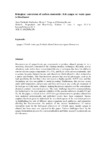Biological conversion of carbon monoxide: rich syngas or waste gases to bioethanol

Use este enlace para citar
http://hdl.handle.net/2183/13730Coleccións
- Investigación (FCIE) [1227]
Metadatos
Mostrar o rexistro completo do ítemTítulo
Biological conversion of carbon monoxide: rich syngas or waste gases to bioethanolData
2011Cita bibliográfica
Abubackar HN, Veiga MC, Kennes C. Biological conversion of carbon monoxide: Rich syngas or waste gases to bioethanol. Biofuels, Bioproducts and Biorefining. 2011;5(1):93-114
Resumo
Bioconversion of syngas/waste gas components to produce ethanol appears to be a promising alternative compared to the existing chemical techniques. Recently, several laboratory-scale studies have demonstrated the use of acetogens that have the ability to convert various syngas components (CO, CO2, and H2) to multicarbon compounds, such as acetate, butyrate, butanol, lactate, and ethanol, in which ethanol is often produced as a minor end-product. This bioconversion process has several advantages, such as its high specificity, the fact that it does not require a highly specific H2/CO ratio, and that biocatalysts are less susceptible to metal poisoning. Furthermore, this process occurs under mild temperature and pressure and does not require any costly pre-treatment of the feed gas or costly metal catalysts, making the process superior over the conventional chemical catalytic conversion process. The main challenge faced for commercializing this technology is the poor aqueous solubility of the gaseous substrates (mainly CO and H2). In this paper, a critical review of CO-rich gas fermentation to produce ethanol has been analyzed systematically and published results have been compared. Special emphasis has been given to understand the microbial aspects of the conversion process, by highlighting the role of different micro-organisms used, pathways, and parameters affecting the bioconversion. An analysis of the process fundamentals of various bioreactors used for the biological conversion of CO-rich gases, mainly syngas to ethanol, has been made and reported in this paper. Various challenges faced by the syngas fermentation process for commercialization and future research requirements are also discussed.
Palabras chave
Syngas
CO-rich waste gas
Biofuel
Ethanol
Homoacetogens
Bioreactor
CO-rich waste gas
Biofuel
Ethanol
Homoacetogens
Bioreactor
Versión do editor
Dereitos
The definitive version is available at http://onlinelibrary.wiley.com/





